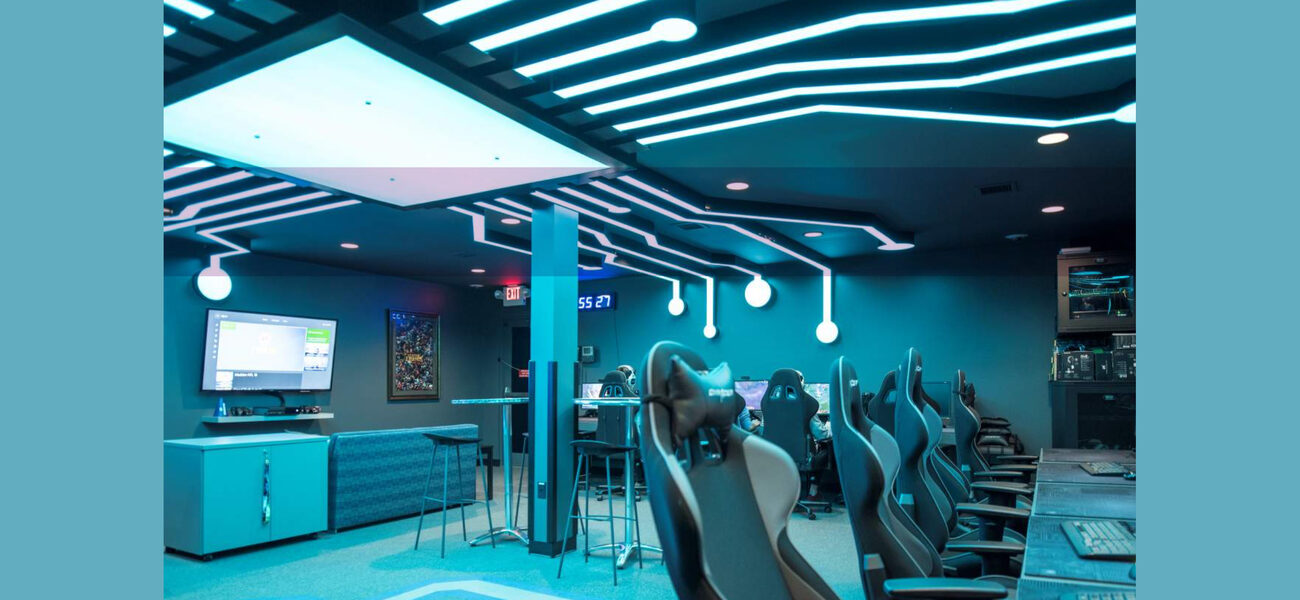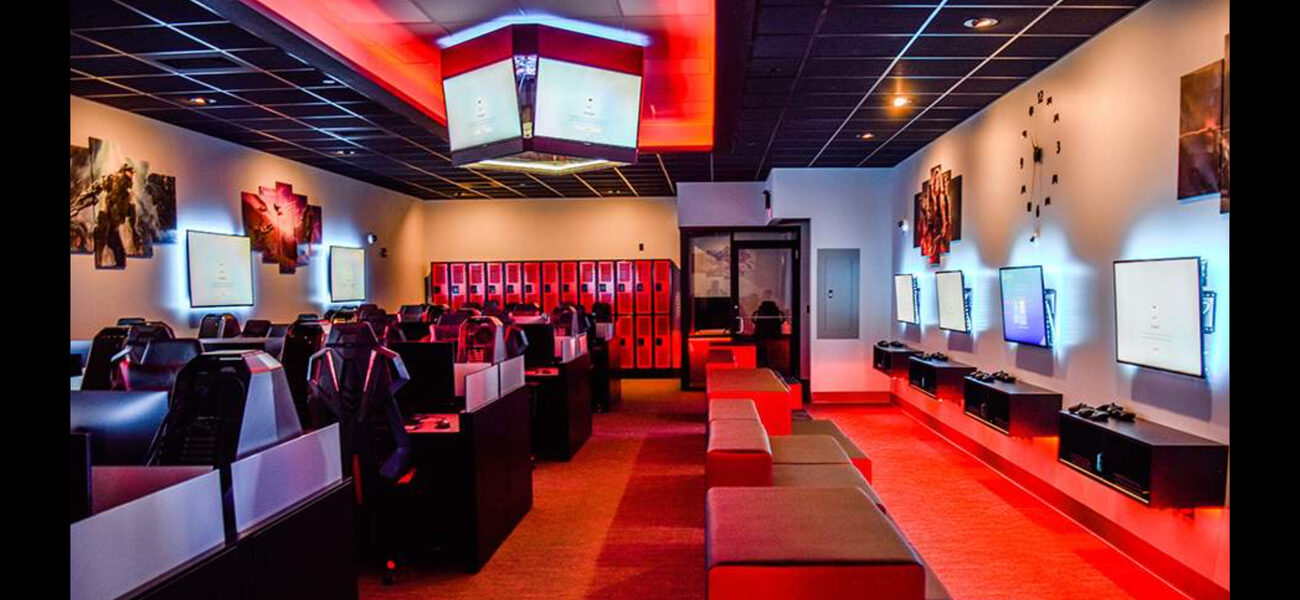A few years ago, Columbia College in Missouri had a small maintenance garage that wasn’t adding much value. Today, it’s the Gaming Hut, the nexus of Columbia’s esports program, part of a trend on many campuses that’s getting video gamers out of their dorm rooms and into a world of collaboration, competition, and learning. An esports facility is “a perfect example of a small space being reclaimed, a social space with performance and practice areas,” explains Chris Chivetta, president of Hastings+Chivetta Architects, which has worked on a number of these projects. “This is a business model that’s changing curriculums and creating new spaces on campus.”
What is Esports?
Esports is video gaming, but it’s more than just sitting by yourself playing. The most popular esports games are team sports, and an esports facility can include well-designed team computer workstations, as well as room for crowds of spectators, large video screens to view the action, and more informal areas for casual gamers.
It’s a huge, global business, and it’s growing fast. The world championship in Fortnite, a popular online game, awarded $3 million to its 16-year-old winner. The most popular esports game, League of Legends, attracted more than 200 million viewers in 2018—nearly double the number who watched the Super Bowl that year.
You don’t have to be an elite player to earn real money streaming your gaming experiences on an online platform like Twitch. And while esports competitors do trend largely male, more women are taking part as players and spectators.
Depending on an institution’s goals, an esports facility can range from a modest gaming space to a full-scale arena. Many colleges and universities are now actively recruiting top players—a much easier chore than recruiting athletes, since esports players’ stats are all available online. Corporations are sponsoring programs, computers, equipment, and other parts of the gaming centers for top-rated university teams.
Institutions are also adding programming and scholarships keyed to esports, says Will Schenck, a project designer at Hastings+Chivetta.
Saint Louis University, for example, organized its first esports club team in 2017 and now offers 12 scholarships of up to $2,000 for members of the varsity esports team. A space in the basement of the student center was converted into the Esports Gaming Lab, featuring 12 stations for computer gaming and three large TV monitors.
“Parents who may be skeptical of esports and video games, as soon as their student can come home and say ‘Mom and Dad, I just got an $8,000 scholarship offer to play Overwatch at this university,’ suddenly something clicks in their brains and they think, ‘Maybe there is something to this,’” says Schenck. “In the last year, we have seen a dramatic increase in esports interest from high schools and even elementary schools. This is certainly a global phenomenon spanning all age groups.”
Why Should Institutions Invest in Esports?
Institutions have long invested in student life, recreational and athletic facilities to match students’ interests. Chivetta and Schenck point out that esports can build cross-disciplinary connections among people with interests as diverse as marketing, computer science, communication, and management.
Some institutions have built creative bridges to esports, for instance, involving nutrition and physiology programs in determining the best health regimens for gamers; and setting up interest groups for broadcasting students who want to become “shoutcasters,” the people who call the play-by-play in esports competitions. This video of the Maryville University team winning the 2017 League of Legends title provides an exciting example of how this all works.
In an era where every institution is competing against online programs for students, something that can turn around an enrollment slide is especially valuable. In addition, a competitive team can be an inexpensive way to publicize a college’s name and offerings.
“Esports bring people together from across campus,” says Chivetta. “It’s a sport anybody can do.” The programs are hugely popular with students and prospects, and many institutions report a return on their investment in the form of increased applications from students with stronger academic records. “They can now show that they have an esports area where students feel socially engaged.”
The presence of an esports facility on campus also brings in corporate recruiters from technology and gaming companies, aware that the esports players are also likely to be the people best suited to careers in coding, project management, or graphic design.
“You’ll see a lot of smaller colleges, universities, and community colleges that are trying to get their name out there and get on the map,” says Schenck. “They’re investing in esports.”
For example, he points to Central Maine Community College in Auburn, Maine, which invested $200,000 in an esports arena that opened in 2019. At the same time, the college established a degree program in esports management, focusing on the business side of the industry. “This is one of the first stops on their admissions tour,” he says.
That holds true even if your gaming facility is a repurposed maintenance garage, adds Schenck. “If you go to an esports convention, everybody knows about Columbia College in the middle of Missouri. It’s amazing how it put them on the map.
Multiple Models
As the esports field grows, many institutions are faced with the choice of where to locate it in the college or university. All have their pros and cons.
On some campuses, it’s handled under athletics, which makes sense in some ways—athletic programs are familiar with the phenomenon of students who can make big money playing their game. On the other hand, many athletic programs aren’t familiar with esports, while players may be leery of situations where they have to follow NCAA rules.
Student life and recreation programs have also taken on responsibility for esports, but then run into issues with branding and imaging, or are overwhelmed by the challenge of hosting a tournament that may attract thousands of people.
“The model that’s more prevalent today is coming under the sports club model, under recreational services or student life, where it’s not controlled by athletics but there is some kind of management oversight to it,” says Chivetta.
Design Considerations for Esports Facilities
It’s possible to create esports spaces that are fairly small and low-budget, but some investments will pay off in terms of student interest and value to the institution, say Chivetta and Schenck. As with any project, the better the planning and goal-setting, the more useful the space is likely to be.
Start by defining esports for your school. If the intention is to field a competitive team, the space should include a competition area with spectator seating and large screens to display the action to viewers. Teams are usually five players, though it’s often wise to arrange gaming stations in groups of six to allow room for an alternate player or easy access to a fresh computer if one fails.
More casual gaming areas can be arranged more informally, and competitors like a “warmdown” space where they can play lower-pressure games after their intense sessions. Because gamers tend to be night owls, it’s important to locate your gaming space in a space that’s accessible at night and into the wee hours.
Even though they might spend their time looking at screens, gamers will appreciate lively surroundings. Schenck advises making wall graphics and lighting as exciting as possible. “Video gamers love the drama; they love the LED lights. Just go crazy with that.” The décor also offers opportunities to build excitement around the team’s name and branding.
“Bring in nice furniture,” adds Schenck. “Gaming chairs are very important to make sure they have correct posture. Your esports athletes will expect the best in their gaming chairs.”
Sufficient power and internet bandwidth are musts, of course. And if you’ve ever been a gamer, you’ll agree with Schenck’s advice about ventilation. “You’ve got 20 students playing hard for four hours a day. You can very quickly get that locker room effect and scent throughout the room if you don’t have proper air changes.”
All in all, Chivetta and Schenck estimate that renovating a classroom space for esports will cost $80 to $120 per sf, while renovating unfinished space, such as Columbia’s garage, runs more like $180 to $220 per sf. In addition, the program needs to invest in high-end gaming PCs with a plan to replace them every couple of years.
Of course, you don’t have to go small. Full Sail University in Florida spent $6 million renovating a former television studio into an esports tournament space, including a concert-level PA system and 10 million pixels of LED wall. It can handle 100 gamers at a time, and up to 500 spectators. “It’s a showstopper,” says Schenck.
Most institutions also hire an esports coach, often a former pro gamer. Elite gamers’ careers end at around age 23; after that, humans just aren’t as capable of the super-quick eye-hand coordination and response times that esports demand, so they turn to coaching. An esports coach requires enough room around workstations to be able to see and interact with players without crowding them. An office for the coach is included in some facilities, as are a “war room”—basically a conference area where a team and coach can meet and plan strategies—and a broadcasting area.
An Esports Success Story
Schenck has toured the esports facility at Harrisburg University in Pennsylvania, and tells the story of its program.
“The president of the university had a decision: Should they invest millions of dollars to go into traditional athletics at a low division three or division two level, and probably lose a lot of money on that venture? Instead, they decided to invested $500,000 in their esports team.
“They hired an ex-professional from the Philadelphia Fusion to be their coach. They built this terrific space in the basement of a theater, and it became a huge recruitment tool for them.
“Within a year they were broadcast live on ESPN for an hour in an Overwatch championship, which they won. During that one-hour broadcast Harrisburg University was mentioned 90 times. The president of the university said $500,000 could not have bought that much advertising exposure for their university.”
By Patricia Washburn
| Organization | Project Role |
|---|---|
|
Hastings+Chivetta, a GHC | Orcutt Winslow Studio
|
Architects
|



